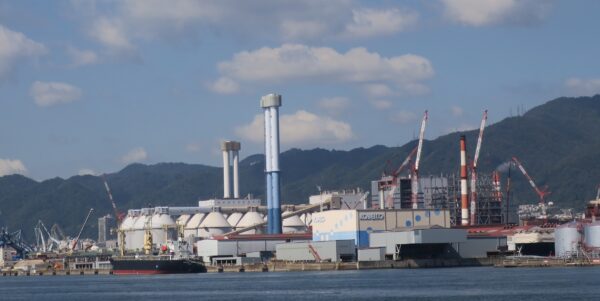The final hearings in Osaka District Court (presiding judge: Kenichi Mori) finished on January 20, 2021, as part of an administrative lawsuit challenging a coal-fired power plant construction project by Kobe Steel Ltd. (Kobelco) in Nada-ku, Kobe, Japan that has been in the courts for more than two years.

The Kobe Climate Case: Summary and Issues
In this administrative lawsuit, 12 local residents are targeting an expansion project at a Kobe Steel coal-fired power plant and asking the courts to revoke a “notice of finalization of environmental assessment,” asserting that the central government approved the construction despite the illegality of the environmental assessment procedure.
The application for construction went through an environmental impact assessment process that started in December 2014, and on May 22, 2018, the notice of finalization was issued by the Minister of Economy, Trade and Industry, after which Kobe Steel began construction work in October that year. However, the plaintiffs and their legal team claim that the investigation, projections, and assessments of the project’s impacts on lives and health due to air pollution and climate change were not conducted properly, including the following points:
• Annual CO2 emissions of 13.71 million t-CO2
Unit 3 and Unit 4 in this project are expected to start operating in 2021 and 2022, respectively. Units 1 and 2 at the existing coal-fired power plant (supercritical technology, or SC) already emit 6.79 million t-CO2 annually, and if the 6.92 million t-CO2 of emissions expected from Units 3 and 4 (ultrasupercritical technology, or USC) are added, the total annual emissions will be 13.71 million t-CO2. Total indirect CO2 emissions each year from Kobe amount to 8.09 million t-CO2, which means that the expanded Kobe Steel coal power plant – just one plant – would exceed those emissions every year going forward. The construction of new coal-fired power generation and the resulting increase in emissions is in conflict with the Paris Agreement, contradicts today’s need to shift to a decarbonized society, and is not consistent with Japan’s net-zero emissions goal by 2050 as pledged by Prime Minister Yoshihide Suga in October 2020.
• Threat of worsening Kobe air pollution
Due to air pollution, the area around the Kobe plant is already designated as an area with industrial pollution. In the midst of Japan’s postwar economic development, the area faced serious problems with health impacts from air pollution, and even now a variety of measures are in place to improve the environment. Despite this, over the course of several years the environmental quality standards for particulate matter (PM2.5) are not always met, and in some areas air pollution concentrations of nitrous oxide (NOx) also exceed the regulatory limits. All efforts should be made to avoid any further deterioration in air quality that would result from constructing large new coal-fired power plants.
• Role of environmental impact assessments for coal-fired power plant construction, and the responsibilities of the central government in approvals
Currently in Japan, there are no installation permit application procedures required for approval by the central government when constructing coal-fired power units. Based on the Environmental Impact Assessment Act and the Electricity Business Act, which stipulates special provisions, the business operator is required to investigate, forecast, and evaluate the environmental impacts in advance. Construction work on a plant can begin if the Minister of Economy, Trade and Industry issues a “notice of finalization of environmental assessment” for the final “environmental impact statement” prepared by the applicant. However, in order to promote the construction of coal-fired power plants (which have twice the CO2 emissions of natural gas) since the accident at TEPCO’s Fukushima Daiichi Nuclear Power Plant in 2011, the government has accepted simplified environmental assessment procedures, leading to the construction of many coal-fired power plants around the country. As of January 2021, 159 units were operating at coal-fired power plants in Japan, and an additional 16 units were planned or under construction. As concerns about climate change continue to grow, can it be said that the environment was adequately considered with the central government decision to continue promoting the construction of coal-fired power plants?
Role of the courts in the spotlight
Responding to the surge in new construction plans for coal-fired power plants, local residents in Japan have been raising their voices in opposition. To date, citizens’ groups have launched campaigns to oppose new plant construction in Kushiro, Sendai, Chiba (Ichihara, Soga, and Sodegaura), Yokosuka, and Kobe. In the Kobe Climate Case, local residents have also initiated a lawsuit seeking an injunction to stop coal-fired power plant construction and operation, targeting three companies including Kobe Steel, and the court case is ongoing.
Climate change is a problem that involves science, politics, and policy, and it is also a human rights issue as it endangering people’s lives, health, and the basis of their livelihoods. As the climate crisis worsens, the role of the judiciary is being called into question in the context of the need for action on climate change.
The judgment on the lawsuit is expected on March 15, 2021. Many eyes will be watching the court’s judgment in this administrative lawsuit, which puts a spotlight on the responsibilities of the Japanese central government in relation to this project.
Reference Links
Kobe Climate Case (Link)
Local Activities: Kobe (Link)
(Translated: February 19, 2021)
